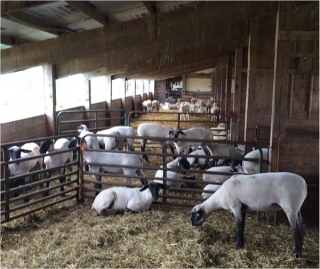
Don't Be Sheepish About Lamb
14 August 2018MATC’s John Reiss takes instructors on a lamb tour from farm to table and everything in between.
By John Reiss, Milwaukee Area Technical College, CEC, CCE and TheCulinaryPro.com
Americans don’t eat much lamb, but they should because it is a great tasting red meat option. Traditional yet versatile, lamb is available in a variety of forms and price points that every chef should include on their menu. While imported lamb is readily available, some of the best lamb can be found by local farmers throughout the United States.
Sheep, Lamb, Mutton – What’s the Difference?
Sheep are domesticated animals and the term is often assigned to the adult animals over one year of age. Lamb indicates baby sheep that are the offspring of ewes (females) and under a year old. The "lamb" term also applies to the meat of young sheep which can be from the male or the female. Mutton is the meat from mature sheep that are over one year.
Where They are Raised and Sourced?
Lamb is the principal meat consumed in regions of North Africa, the Middle East, India, and parts of Europe. The European Union is the largest lamb consumer and number one importer of lamb; mostly brought in from Australia and New Zealand. Mongolia, Turkmenistan, New Zealand, Iceland and Greece are the countries with the highest per capita consumption.
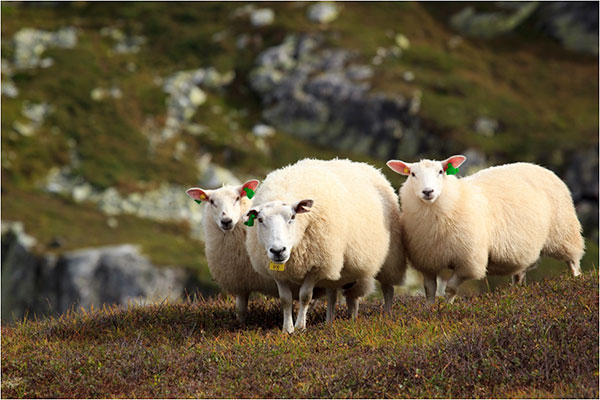 Lamb accounts for less than 1 percent of meat sales in the United States and the average annual consumption is about 1 pound or 450 grams per person. Comparatively, Americans eat more than 50 pounds of beef and over 90 pounds of chicken each year. Still, the US doesn't produce enough to meet the consumer demand so imports, primarily from New Zealand and Australia, comprise more than 50 percent of domestic consumption.
Lamb accounts for less than 1 percent of meat sales in the United States and the average annual consumption is about 1 pound or 450 grams per person. Comparatively, Americans eat more than 50 pounds of beef and over 90 pounds of chicken each year. Still, the US doesn't produce enough to meet the consumer demand so imports, primarily from New Zealand and Australia, comprise more than 50 percent of domestic consumption.
Every state produces lamb with Texas, California, Colorado, Wyoming, and South Dakota producing more than two thirds of domestic sheep. Ethnic minorities are the biggest consumers, including Latinos, but especially Muslims who want their lamb processed according to Halal, an Arabic word meaning lawful or permitted. Halal slaughter involves minimizing stress to the animal, turning its head toward Mecca, and saying a blessing known as the basmala prayer. The throat is then slit and the blood drained from the carcass.
Sheep are also raised for milk and cheese production. Greek Feta, French Roquefort, Spanish Manchego and Italian Pecorino Romano are some well-known varieties. The United States is the largest importer of sheep’s milk cheese, accounting for about half of the world’s consumption.
How Sheep Are Raised and Finished
Most American sheep are pasture raised and finished on a variety of grains. This gives the meat a rich, meaty, or even “beefy” flavor. A few raise their sheep on grass or pasture only.
New Zealand has a long history of raising and exporting sheep, where they were first introduced by British explorer Captain James Cook in 1773. New Zealand lamb are smaller than American, strictly grass-fed, and tend to have a more pronounced, lamb-like “gamey or grassy” flavor.
Australian lamb is grass fed and finished, but some farmers are moving to a practice of grain finishing on feedlots, so the flavor is similar to American lamb. Carcass size is smaller than American lamb but larger than New Zealand varieties. Both New Zealand and Australia raise dual-purpose sheep for wool and meat production.
Most US sheep are raised by a network of hundreds of small family farms and ranchers. According to the American Lamb Board, “There are more than 80,000 family farmers and ranchers caring for over 6 million sheep throughout the United States.” These farmers are committed to practicing good land management, animal well-being, and natural grazing that is compatible with the environment. Some proprietary labels, including Niman Ranch and Strauss, have established their own programs for raising and feeding animals in a humane manner that eliminates hormones and antibiotics and uses 100 percent vegetarian diet.
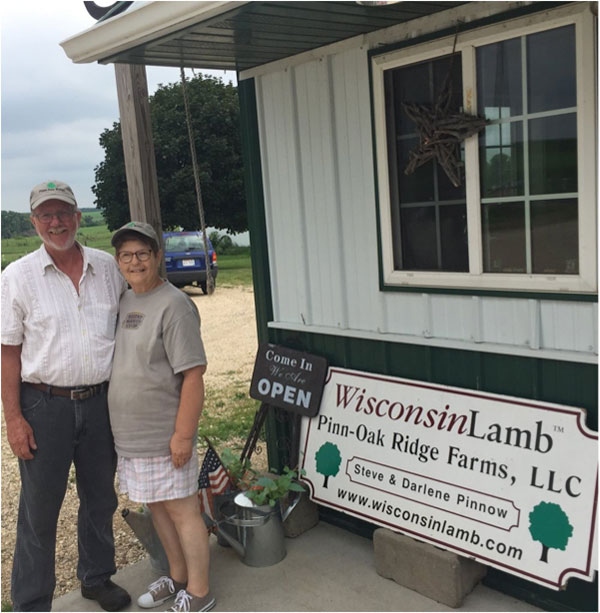 Pinn-Oak Ridge Farms, operated by Steve and Darlene Pinnow, is indicative of the holistic approach to raising lamb. Under the brand Wisconsin Lamb, they work with about 50 small family farms throughout Southeastern Wisconsin following strict protocols that include pasture-grazing and finishing on a diet of grains, corn, and soybeans. Harvested under 10 months of age at 120-140 lbs./54-63 kg the meat has a mild taste and tender consistency. In addition to managing their own flock of ewes, the Pinnow’s operate a federally inspected processing facility and distributes their lamb to about 150 different clients that includes grocery stores and some of the best chefs and restaurants in Southeastern Wisconsin and the Chicago area.
Pinn-Oak Ridge Farms, operated by Steve and Darlene Pinnow, is indicative of the holistic approach to raising lamb. Under the brand Wisconsin Lamb, they work with about 50 small family farms throughout Southeastern Wisconsin following strict protocols that include pasture-grazing and finishing on a diet of grains, corn, and soybeans. Harvested under 10 months of age at 120-140 lbs./54-63 kg the meat has a mild taste and tender consistency. In addition to managing their own flock of ewes, the Pinnow’s operate a federally inspected processing facility and distributes their lamb to about 150 different clients that includes grocery stores and some of the best chefs and restaurants in Southeastern Wisconsin and the Chicago area.
It should be noted that U.S. Food and Drug Administration (FDA) allows hormones and antibiotics to be used in lambs slaughtered for meat. Antibiotics may be given to prevent or treat disease in lambs and hormones may be given to promote growth. So, if chefs are concerned about their use, look for producers who have established protocols that don’t use them.
Comparison of Lamb Sizes
American lamb runs larger in size than imported varieties from Australia and New Zealand. Harvested weights often run up to 50 percent larger because the grain-finish bulks them up. See the chart for a comparison of sizes.

Flavors of Lamb
The flavor of lamb depends on how it is raised. American lamb are mostly pastured or barn-raised on grasses and grain finished from 30 to 70 days producing a larger weight class that is fattier. New Zealand lamb are strictly pasture-raised on grasses which produces a leaner, smaller carcass with a grassy, more pronounced lamb flavor.
Age is a factor in lamb flavor too with younger animals under one year, tasting milder, while those over a year or two (yearlings and mutton respectively) have a much stronger flavor. The best tasting lamb is under a year old, often 6-10 months. Some farmers say grass fed tastes better because they grow slower and are less fatty, while others prefer the taste of a grain finish. It really comes down to personal preference and often cultural tradition is a factor too. Most people who grew up eating grass-fed lamb prefer the heartier taste, while Americans, who are big beef eaters, like the taste of grain-finished lamb.
 Lamb Processing
Lamb Processing
Lamb is purchased whole or processed into primal cuts, sub-primal, or portion cuts. What form a chef instructor chooses to purchase depends on the needs in his or her kitchen. Some chefs like the idea of whole animal utilization which requires a commitment to using all the parts of the animal including the bones, fat, and odd parts such as the neck, ribs and shanks. Primal cuts, including the rack, leg, or shoulder are another option when doing in-house fabrication. The convenience of portion cuts eliminates the added prep work and less trim but will always cost more.
Inspection and Quality Grading
All lamb sold in the United States must be either USDA inspected for wholesomeness or inspected by state systems which have standards equal to the Federal government to ensure that it is safe to eat. Quality grading is an optional system that rates factors including tenderness, juiciness, and flavor. USDA-graded lamb sold at the retail level is Prime, Choice and Good. Lower grades (Utility and Cull) are mainly ground or used in processed meat products. Since quality grading is optional, ungraded lamb is also available, which may be lower or higher than USDA graded lamb. When considering the purchase of ungraded lamb, it always pays to know the supplier or farmer.
Aging
Lamb is sometimes aged to develop additional tenderness and flavor. Usually only the higher quality, more expensive primals, such as racks, loins, and legs are aged, and these are mainly sold to restaurants. Wet-aging begins when the meat is vacuum packaged after processing, and dry-aging is done by hanging the meat in a temperature and humidity-controlled cooler. Aging lamb for 7-14 days will develop tenderness and intensify flavor, additional aging will produce funkier flavors.
Lamb Cuts
While Lamb can be purchased a few different ways including primal, sub-primal, and portion cut, most customers purchase sub-primal or portion cuts. Lamb terminology differs from other species. Instead of a steak, purchasers get a chop while a rack is the same cut as a beef prime rib roast. Lamb rib chops, racks, and shanks are sometimes cleaned of fat to expose their bones, a technique known as Frenching.
Primal Cuts - Bone-In Leg, Loin, Hotel Rack (Rib), Shoulder, Saddle (Loin)
Sub Primal Cuts - Rib Roast, Boneless Loin, Boneless Leg, Shank, Boneless Shoulder
Portion Control Cuts - Frenched Lamb Rack, Rib Chop, Loin Chop, Shoulder Chops, Leg
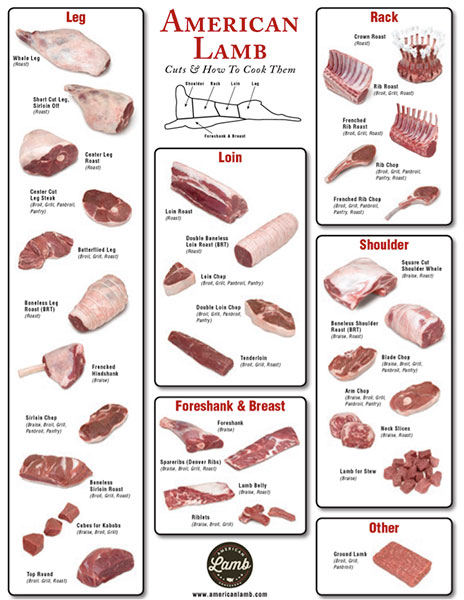
Fabrication
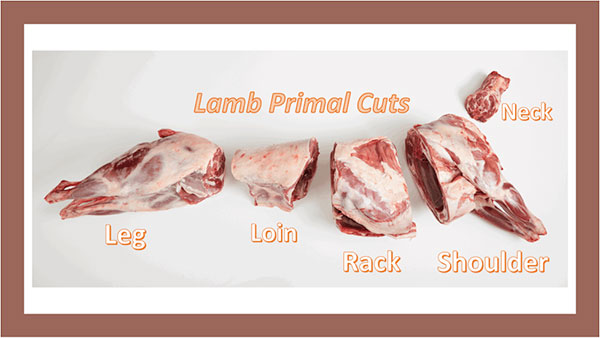
Understanding carcass structure aids in the breakdown, cutting and portioning of lamb for service. Always start with a clean work station, sanitized equipment and sharp tools. Keep the meat as cold as possible. Use a saw to cut through bone and a knife to cut through muscle. Wear a mesh glove to prevent accidental cuts.
Understanding the basic skeletal and muscle structure aids in cutting accuracy, maximizing your yield, and uniformity of portion cuts.
The American Lamb Board has a great website featuring Curriculamb with videos and recipes for every lamb cut.
Download step-by-step fabrication PDF tutorials from American Lamb
Preparing Lamb
Prepare lamb as if it were any red meat. Remember that the cuts in the middle, including the rack and loin, are best cooked by dry heat methods including grilling, broiling and pan-searing. The legs are ideal for roasting, while braising and stewing are the best methods for the shoulder and shanks.
Check out these preparation videos by Chef Chris Koetke:
The Basics of Braising and Stewing and How to Prepare Lamb Shanks with Kale
https://www.youtube.com/watch?time_continue=1&v=RAXDnhYTGm8
Roasting a Leg of Lamb
https://www.youtube.com/watch?v=Ip9ikjDbuTE
Grilling Lamp Chops
https://www.youtube.com/watch?v=Ebza2NJbMoU
Barbecuing Lamb
https://www.youtube.com/watch?v=XuZVxo4I3wo
Photo 1 (Cover Photo): Courtesy Pinn-Oak Ridge Farms
Photo 2: by Frantisek Duris on Unsplash
Photo 3: The Pinnows at their Farm
Photo 4: Pinn-Oak Ridge Farms
Photo 6: Courtesy TheCulinaryPro.com
